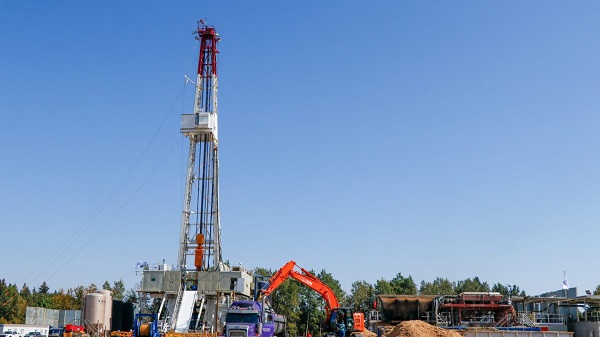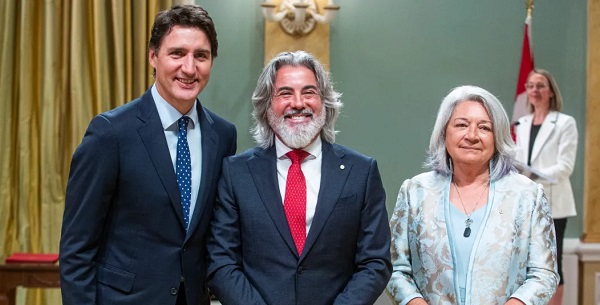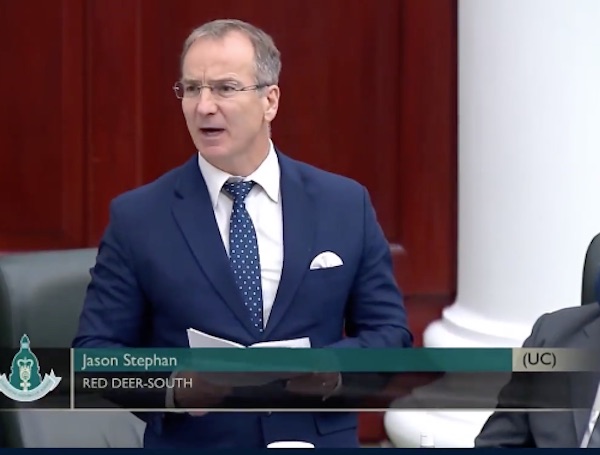Alberta
Rocky View County murder. RCMP charge one with first degree murder; searching for second suspect

News release from Strathmore RCMP
The Alberta RCMP have now laid charges in connection with the tragic shooting which occurred in Rocky View County on Aug. 6, 2024. RCMP have charged Edmonton resident 35-year-old Arthur Wayne Penner with the first-degree-murder of Airdrie resident Colin John Hough as well as attempted murder of another individual. Penner has been arrested and taken before a justice of the peace. He has been remanded into custody with his next court date set for Aug. 15, 2024, at the Alberta Court of Justice in Airdrie.
Additionally, RCMP continue to search for the second suspect in the shooting. Elijah Blake Strawberry, 28-years-old, now has a warrant for his arrest for the second-degree-murder of Colin Hough. RCMP are asking for the public’s assistance in locating Strawberry.
Elijah Strawberry is described as:
- Light complexion
- 6 feet 1 inch tall
- 169 pounds
- Several arm and face tattoos.
- Brown Hair
Elijah Strawberry is considered armed and dangerous. If seen do not approach dial 911 immediately.
The Alberta RCMP wish to offer a timeline into the investigation that led to both an arrest and a warrant for arrest.
On Aug. 6, 2024, around noon hour, officers from the Strathmore RCMP received a report of two men who had been shot while doing work along a roadway on Township Road 250 and Range Road 281 in Rocky View County. Upon arriving on scene, emergency crews discovered that Colin Hough and a 39-year-old victim had both been shot during an attempted robbery by two, then unknown, individuals. The suspects burnt the stolen vehicle they arrived to the scene in, and stole one of the victim’s Rocky View County pick-up trucks.
Responding officers were able locate the suspects in the Rocky View County pick up truck and engaged in a pursuit, however the suspects were successful in evading police.
Soon after, using the Rocky View County pick-up truck on-board GPS, police were able to locate the truck abandoned in a field in the area of Range Road 252 and Township Road 260. Faced with the potential of armed suspects in area, RCMP issued a Police-Initiated Public Alert advising residents in the area to shelter in place. Strathmore RCMP, with assistance of our Emergency Response Team, Calgary Police TAC, Calgary Police Dog Service, the Alberta RCMP helicopter, Calgary HAWCS, drones, and neighbouring detachments, conducted a thorough search of the area. At this point in time police had limited and vague descriptions of the suspects involved in the incident. Providing vague or potentially inaccurate information to the public about the suspects at this crucial time could have been misleading and potentially dangerous.
After conducting a thorough search, RCMP were satisfied that the suspects could no longer be in the area and the immediate risk to residents had subsided. Police at this time lifted the shelter in place and continued to investigate.
After continued investigation, police learned that the suspects, during an unrelated incident, were involved in a minor collision in Calgary in which the stolen vehicle they were driving was partially disabled. They then drove to where the shooting victims were working and attempted to steal a new vehicle. It was at this time both victims were shot.
On Aug. 8, 2024, RCMP determined that Arthur Wayne Penner was one of the suspects. Immediate actions were taken to set up surveillance on Penner and liaise with Alberta Crown Prosecutors to obtained charge approvals. Once the approval was received, RCMP with assistance from Edmonton Police Service, safety arrested Penner in Edmonton.
On Aug. 11, 2024, police identified Elijah Strawberry as the second suspect in this incident. Today, after receiving crown approval, RCMP have obtained a warrant for his arrest. We ask that anyone who sees him or as information about his whereabouts call 911.
“I want to assure everyone that the RCMP has done, and continue to do, everything in our power to swiftly investigate and arrest these dangerous suspects. I give my most heartfelt condolences to the family and friends of Colin Hough who was out working and making a living when these individuals took his life,” says Staff Sergeant Mark Wielgosz, “I also want the other victim in this tragedy to know that our thoughts are with him as well.”
Despite these charges, the RCMP’s investigation continues:
- We continue to work at identifying the occupants of Black Volkswagen Jetta as they may have witnessed this incident. We ask for these individuals to come forward.
- We believe that a quad stolen on Aug. 7, 2024, a 1:34 p.m. in Wheatland County maybe be connected to our investigation. We ask that members of public check their dash cam footage and surveillance cameras if they have seen the quad or its occupants.
Elijah Strawberry is considered armed and dangerous. If seen do no approach – dial 911 immediately. Alberta RCMP are still seeking public’s help with video footage and information surrounding this incident. If you have information about this incident or those responsible, please call the Strathmore RCMP at 403-934-3535. If you want to remain anonymous, you can contact Crime Stoppers by phone at 1-800-222-8477 (TIPS), online at www.P3Tips.com or by using the “P3 Tips” app available through the Apple App or Google Play Store.
Alberta
Emissions Reduction Alberta offering financial boost for the next transformative drilling idea

From the Canadian Energy Centre
$35-million Alberta challenge targets next-gen drilling opportunities
‘All transformative ideas are really eligible’
Forget the old image of a straight vertical oil and gas well.
In Western Canada, engineers now steer wells for kilometres underground with remarkable precision, tapping vast energy resources from a single spot on the surface.
The sector is continually evolving as operators pursue next-generation drilling technologies that lower costs while opening new opportunities and reducing environmental impacts.
But many promising innovations never reach the market because of high development costs and limited opportunities for real-world testing, according to Emissions Reduction Alberta (ERA).
That’s why ERA is launching the Drilling Technology Challenge, which will invest up to $35 million to advance new drilling and subsurface technologies.
“The focus isn’t just on drilling, it’s about building our future economy, helping reduce emissions, creating new industries and making sure we remain a responsible leader in energy development for decades to come,” said ERA CEO Justin Riemer.
And it’s not just about oil and gas. ERA says emerging technologies can unlock new resource opportunities such as geothermal energy, deep geological CO₂ storage and critical minerals extraction.
“Alberta’s wealth comes from our natural resources, most of which are extracted through drilling and other subsurface technologies,” said Gurpreet Lail, CEO of Enserva, which represents energy service companies.
ERA funding for the challenge will range from $250,000 to $8 million per project.
Eligible technologies include advanced drilling systems, downhole tools and sensors; AI-enabled automation and optimization; low-impact rigs and fluids; geothermal and critical mineral drilling applications; and supporting infrastructure like mobile labs and simulation platforms.
“All transformative ideas are really eligible for this call,” Riemer said, noting that AI-based technologies are likely to play a growing role.
“I think what we’re seeing is that the wells of the future are going to be guided by smart sensors and real-time data. You’re going to have a lot of AI-driven controls that help operators make instant decisions and avoid problems.”
Applications for the Drilling Technology Challenge close January 29, 2026.
Alberta
New era of police accountability

The Police Review Commission (PRC) is now fully operational, giving Albertans a single, independent process to file policing complaints and ensure accountability.
Alberta’s government is putting the province at the forefront of police oversight in Canada with the creation of the PRC. This new commission replaces the current patchwork of police investigating police with one independent body responsible for receiving complaints, conducting investigations and overseeing disciplinary hearings. By centralizing these functions within a single, independent agency, Alberta is ensuring complaints are handled fairly and consistently.
“The Police Review Commission represents a new era in how Alberta addresses policing complaints. These changes are part of a broader paradigm shift where police are no longer seen as an arm of the state, but rather an extension and a reflection of the community they serve. As an independent agency, it is committed to fairness, accountability and public trust, ensuring every complaint is investigated impartially and resolved openly.”
The Police Amendment Act, 2022 laid the groundwork for this new model, establishing a modern approach to oversight built on accountability, consistency and public confidence. The PRC will manage the full complaints process from receiving and assessing, to investigating and resolving complaints related to police conduct, including serious incidents and statutory offences.
“The Alberta Association of Chiefs of Police welcomes the launch of the Police Review Commission as a meaningful step toward enhanced oversight and greater transparency in policing. By ensuring complaints are reviewed fairly and impartially, the Commission will help strengthen accountability and reinforce public trust in Alberta’s police agencies. Police leaders across the province are committed to working with the Commission and our communities to ensure every Albertan has confidence in the integrity of our police services.”
A timely and transparent complaint resolution process is essential for both the public and police. That is why the PRC must complete investigations within 180 days, and if more time is needed, the chief executive officer must publicly report on delays and provide justification. This ensures clarity, predictability and accountability throughout the process. The commission will be arm’s length from government and police services, meaning people can have greater confidence that their complaints will be investigated and resolved impartially.
“Our goal is to build trust in policing by delivering timely resolutions and fair, consistent outcomes that put people first. Every complaint will be reviewed thoroughly and handled with the transparency and respect Albertans expect and deserve.”
The PRC can also initiate systemic reviews related to police conduct or emerging trends without the need for a public complaint, and these reviews must be made public. Together, these measures create a clear, accountable process that strengthens transparency, supports continuous improvement and enhances trust in how police oversight is carried out across Alberta.
“Public safety and the confidence the public has in our police services and service members are incumbent for effective and responsible service delivery. The PRC has been developed so that Albertans may have a responsible and impartial mechanism to voice concerns regarding delivery of policing services in Alberta. I am confident that the PRC will be an inclusive and diverse representation of the communities, so we may better understand the most appropriate and effective way to respond to concerns regarding police services. I look forward to the positive outcomes for the community.”
The commission’s design was informed by engagement with Indigenous communities, law enforcement partners, municipal officials and community organizations, ensuring its structure and training reflect Alberta’s diversity and values.
Quick facts
- The PRC will handle complaints in three categories:
- Level 1: Death, serious injury and serious or sensitive allegations involving all police services in Alberta, as well as peace officer agencies.
- Level 2: Allegations of criminal and other statutory offences involving all police services in Alberta.
- Level 3: Complaints about non-criminal misconduct involving officers employed by municipal and First Nations police services.
- Complaints that fall outside the three categories will be referred to the appropriate bodies or agencies for review.
- The Alberta Serious Incident Response Team (ASIRT) will now operate under the PRC.
-

 Agriculture2 days ago
Agriculture2 days agoHealth Canada pauses plan to sell unlabeled cloned meat
-

 Artificial Intelligence2 days ago
Artificial Intelligence2 days agoGoogle denies scanning users’ email and attachments with its AI software
-

 Health2 days ago
Health2 days agoOrgan donation industry’s redefinitions of death threaten living people
-

 National2 days ago
National2 days agoAlleged Liberal vote-buying scandal lays bare election vulnerabilities Canada refuses to fix
-

 COVID-191 day ago
COVID-191 day agoFDA says COVID shots ‘killed’ at least 10 children, promises new vaccine safeguards
-

 Alberta1 day ago
Alberta1 day agoNet Zero goal is a fundamental flaw in the Ottawa-Alberta MOU
-

 Addictions1 day ago
Addictions1 day agoManitoba Is Doubling Down On A Failed Drug Policy
-

 Food1 day ago
Food1 day agoCanada Still Serves Up Food Dyes The FDA Has Banned






